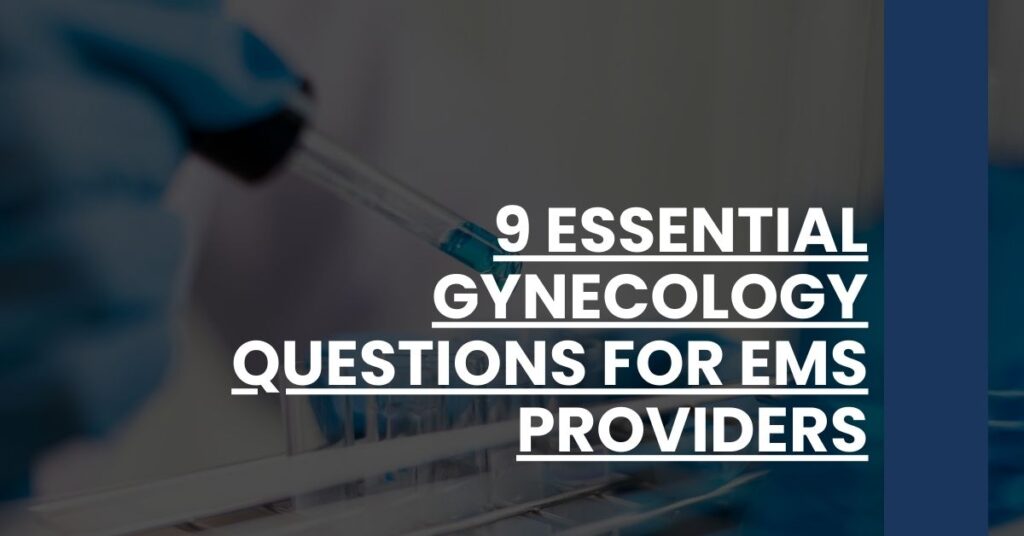Have you ever stood before an urgent gynecological situation, stethoscope in hand, and found yourself scrambling for the right questions?
For EMS providers, knowing what to ask can save lives.
This article cuts through uncertainty, equipping you with essential gynecology questions for EMS scenarios. Discover how to navigate these critical moments with confidence and care, as we delve into the expertise you need most.
Your quick thinking and informed questions can make all the difference—and we’re here to help ensure they do.
- 1. Recognizing Common Gynecologic Emergencies
- 2. Assessing Pregnancy-Related Complications
- 3. Addressing Pelvic Trauma Concerns
- 4. Understanding Menstrual Cycle Irregularities
- 5. Managing Acute Abdominal Pain in Females
- 6. Handling Obstetric Emergencies in the Field
- 7. Navigating Consent and Privacy Issues
- 8. Incorporating Age-Specific Concerns
- 9. Utilizing Pathophysiology Knowledge
- Communication Techniques for Sensitive Topics
- Gender-Specific Considerations for EMS
- Conclusion: Effective Gynecological Inquiry for EMS Excellence
1. Recognizing Common Gynecologic Emergencies
When you’re racing to the aid of a patient, pinpointing the nature of a gynecologic emergency is paramount. Remember, the right gynecology questions for EMS can save lives.
Here’s what to watch for:
- Sudden abdominal pain: Can be a sign of ectopic pregnancy or ovarian torsion.
- Irregular bleeding: Possible indications of miscarriage or ectopic pregnancy, especially if accompanied by severe pain.
- Signs of shock: Such as rapid heartbeat, sweating, and fainting—potential markers of severe blood loss or ectopic pregnancy rupture.
Stay alert for these symptoms that often lay the groundwork for decisive action in gynecological emergencies. Knowledge here is a powerful aid to your quick thinking and astute questioning.
2. Assessing Pregnancy-Related Complications
Pregnancy introduces a range of potential emergencies, from preterm labor to preeclampsia. Your diligent queries form the crux of a critical assessment.
Dig into:
- Last Menstrual Period (LMP): Establish timing for possible pregnancy complications.
- Pre-existing conditions: Inquire about hypertension or diabetes that could complicate pregnancy status.
- Pregnancy history: Prior cesarean deliveries or complications can impact current interventions.
Effective assessment here can not just ease a patient’s distress but also significantly reduce pregnancy-related mortality. Picture yourself not just as a first responder but as a crucial link in the chain of survival.
3. Addressing Pelvic Trauma Concerns
Pelvic traumas are formidable, requiring your immediate attention and precise questioning. Discover if the patient has:
- Fallen or suffered an impact: Basis for potential fractures or internal bleeding.
- Experienced changes in consciousness: Could indicate the severity of blood loss.
Your adept assessment helps you stabilize and manage hemorrhage, setting a course toward recovery before reaching the hospital.
4. Understanding Menstrual Cycle Irregularities
Understanding a patient’s menstrual cycle is more than a cursory part of your assessment—it’s a diagnostic tool in emergencies. A clear picture of cycle irregularities can clue you into potential disorders or conditions.
Ask these clarifying questions:
- Cycle regularity: Has the pattern changed suddenly?
- Pain level: Could indicate conditions like endometriosis or fibroids.
- Associated symptoms: Such as nausea, which could tie into gynecological issues.
In-depth menstrual knowledge aids in making sense of symptoms that might otherwise be ignored.
5. Managing Acute Abdominal Pain in Females
Not all abdominal pain is gynecological, but your role involves discerning potential emergencies.
Here’s how to approach this:
- Location of pain: The site of discomfort can indicate different organ systems.
- Pain severity and onset: Sudden, sharp pain might suggest an acute condition like ovarian torsion.
- Reproductive history: Pregnancy, recent births, or menstrual complications can influence your investigative direction.
This type of critical analysis helps you navigate through a myriad of conditions, as detailed by the Cleveland Clinic, leading to the root cause of discomfort.
6. Handling Obstetric Emergencies in the Field
In the field, obstetric emergencies test your expertise and your ability to act swiftly. Your questions become vital in shaping the intervention:
- Assessment of labor signs: Gauge the immediacy of delivery necessity.
- Identification of complications: Look out for signs of bleeding or hypertension.
- Maternal pain levels and vitals: Critical in decisions regarding immediate transport or on-scene intervention.
Armed with your obstetric emergency toolkit, you’re prepared to manage anything from placental abruption to postpartum hemorrhage. Your prompt care could make all the difference.
7. Navigating Consent and Privacy Issues
Gynecology questions for EMS can delve into deeply private matters, and navigating these personal disclosures requires utmost sensitivity. As emergencies unfold, time is crucial, yet so is respect for your patient’s autonomy and dignity.
Consider these key areas to uphold consent and privacy:
- Immediate necessity: Determine if the patient can provide informed consent, or if the situation is a life-threatening one requiring immediate action.
- Confidentiality: Assure privacy even in chaotic environments and safeguard any details shared by the patient.
- Documentation: Keep a clear record of the consent process, as it’s vital for later hospital care and legal reasons.
In emergencies, your ability to navigate these issues swiftly ensures patient safety and legal protection, building trust in your vital role.
8. Incorporating Age-Specific Concerns
Gynecological concerns can significantly vary by age group. Your gynecology questions for EMS should adapt accordingly, considering your patient’s stage in life.
Focus on age-relevant questions:
- Pediatric patients: Approach with special sensitivity to both the young patient and their guardians, seeking clear, age-appropriate consent.
- Adolescents: Balance respect for the teen’s privacy with the need for guardian involvement when necessary.
- Elderly females: Bear in mind potential comorbidities and common post-menopausal conditions that could affect their emergency situation.
When you tailor your approach, you ensure that each patient receives care that’s as age-appropriate as it is urgent.
9. Utilizing Pathophysiology Knowledge
Your understanding of pathophysiology not only informs treatment but also sharpens your gynecology questions for EMS. This background knowledge empowers you to ask relevant, insightful questions based on the symptoms present.
Examples of pathophysiology-informed questions:
- Possible Etymology: If bleeding, could it be from an ectopic pregnancy? If pain, might it indicate ovarian cysts?
- Systems Affected: Are symptoms indicating a potential systemic issue, such as infection, that could affect multiple organ systems?
- Presentation Patterns: Could symptoms be typical of certain gynecological emergencies we frequently see, like pelvic inflammatory disease?
Your grasp of gynecologic pathophysiology not only guides your questioning but also directs the urgency and specifics of your response.
Communication Techniques for Sensitive Topics
When emergency strikes, the compassion and tact of your communication are as crucial as the medical intervention. Gynecological inquiries, in particular, call for a delicate blend of empathy and professionalism.
To communicate effectively:
- Be Direct but Gentle: Approach sensitive questions with straightforward kindness to ease patient discomfort.
- Be Discreet: Ensure privacy—a quiet environment whenever possible to discuss gynecological concerns fosters trust.
- Be Patient: Give your patient time to process and answer; urgency should not overshadow the need for accurate information.
Mastering these techniques not only helps you obtain vital information but also assures the patient of your empathy and care in these vulnerable moments.
Gender-Specific Considerations for EMS
Gynecology isn’t just women’s health—it’s an intersectional field that may involve patients across the gender spectrum. Your gynecology questions for EMS must reflect an inclusive understanding of gender identity and expression.
Essential points to remember:
- Inclusive Language: Use terms that are respectful of individual gender identity, such as asking for a patient’s preferred pronouns.
- Comprehensive History: Consider gender-specific health history, such as transgender health considerations or hormone treatments.
- Empathetic Approach: Remember that gender-diverse patients may have faced healthcare disparities and approach them with heightened sensitivity.
Integrating gender inclusivity into your practice enriches your care and reflects the diverse world you serve through EMS.
Conclusion: Effective Gynecological Inquiry for EMS Excellence
Your ability to ask the right gynecology questions for EMS scenarios ultimately shapes the quality of the emergency gynecological care you give. As EMS providers, you are the frontline of healthcare, and these questions are tools that sharpen your readiness.
Remember, behind every question lies an opportunity—to deliver comfort, preserve dignity, and foster healing. Your journey as an EMS provider is one of continuous learning, and it’s your empathy and expertise that make all the difference.
Stand confident in your knowledge, and keep honing those essential questions that can change outcomes in your capable hands.
Gynecology questions for EMS are vital for emergency care, enabling providers to assess and address urgent female health concerns.

